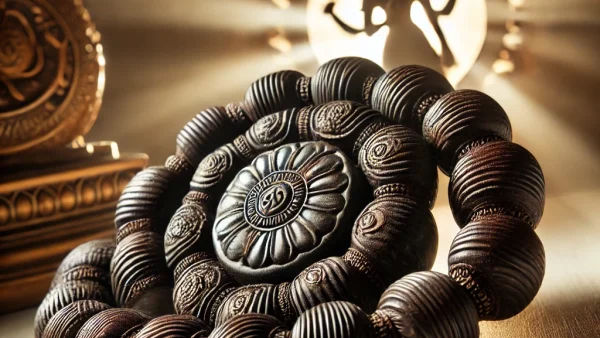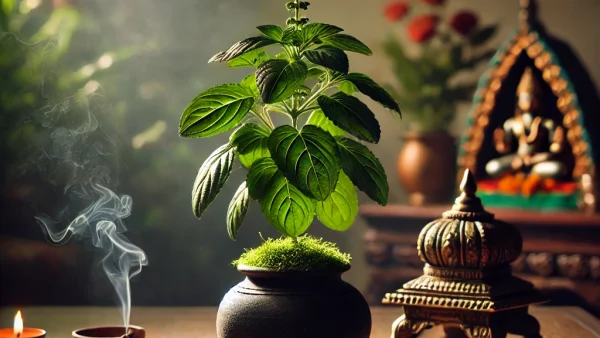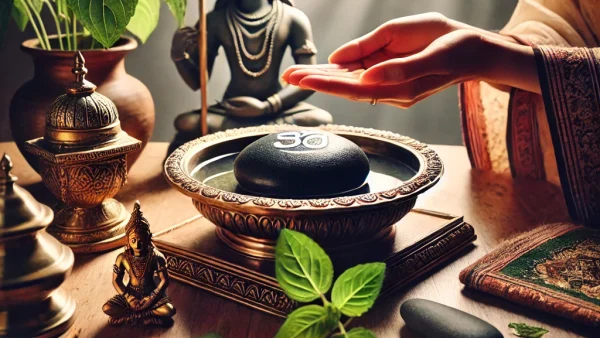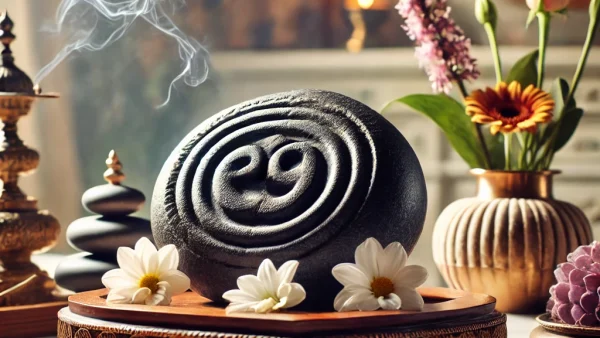Origins of Shaligram
For centuries, the Shaligram has held a special place in the hearts of devotees of Hinduism and Buddhism alike. Revered as a sacred symbol of Lord Vishnu, Shaligrams are more than just stones—they are believed to be the embodiment of the divine itself. But how are these spiritual stones formed? This in-depth exploration will uncover the origins of Shaligrams, delving into their geological, mythological, and spiritual significance.
What is a Shaligram?
A Shaligram is a naturally occurring ammonite fossil, usually found in the riverbeds of the Kali Gandaki River in Nepal. These fossils are remnants of ancient sea creatures that lived millions of years ago during the Jurassic period. Making their journey from deep time to sacred symbol an intriguing one. The distinct spiral patterns and sacred markings seen on Shaligrams are said to represent various forms of Lord Vishnu, making them deeply significant to those who worship him.
Devotees believe that worshipping a Shaligram invites Vishnu’s divine presence into their homes. Creating an aura of protection, prosperity, and spiritual fulfillment. Each Shaligram is unique, and its formation is attributed to both geological processes and divine intervention. A beautiful blend of science and spirituality.
Geological Formation of Shaligram
Tracing Back to Ancient Seas
Shaligrams, as fossils, originate from ancient marine life known as ammonites. Millions of years ago, a vast ocean covered the land where the Himalayas now stand. This ocean was home to various species, including ammonites. Whose coiled shells would later fossilize into what we now recognize as Shaligrams.
As the tectonic plates of the Indian subcontinent collided with the Eurasian plate, the ancient sea receded, and the Himalayas were born. Over time, the fossilized remains of these ammonites were carried down by rivers and streams, eventually settling in the Kali Gandaki River Valley. The unique conditions of this river, including its high altitude, cold temperatures, and fast-flowing currents, helped preserve these fossils, shaping them into the sacred stones that pilgrims and collectors seek today.
Role of the Kali Gandaki River
The Kali Gandaki River, which flows through the Mustang region of Nepal, is the only place in the world where Shaligrams are found in abundance. This river is regarded as sacred in Hinduism and Buddhism, as it is believed to be a manifestation of Goddess Kali. The stones washed down by this river are considered to be imbued with divine energy, having been touched by the goddess herself.
The river’s fast-flowing waters carve and polish the Shaligrams over time, giving them their smooth, distinctive forms. Some of the Shaligrams bear natural imprints that resemble the chakra (wheel) of Vishnu. While others display markings that are said to represent his various avatars, such as Narasimha or Varaha.
Shaligrams in Hindu Scriptures
The formation of Shaligrams is not just a geological process—it is also deeply tied to mythology. Hindu scriptures, such as the Skanda Purana and the Shiva Purana, describe the Shaligram as the divine manifestation of Lord Vishnu. The stones are believed to have emerged from the body of the demon king Jalandhar, who was slain by Lord Shiva. According to the legend, Vishnu took the form of the sacred river Kali Gandaki to wash away the remnants of Jalandhar’s body, which transformed into Shaligrams. Thus, the stones are revered as the remains of the divine and the victorious battle between good and evil.
Shaligrams and the Dashavatara of Vishnu
Each Shaligram is said to represent one of Vishnu’s ten avatars, or Dashavatara. For example, the smooth, round Shaligrams with spiral patterns are associated with the Matsya (fish) avatar. While those with intricate, angular designs are linked to the Narasimha (man-lion) avatar. The connection between the stone’s physical appearance and Vishnu’s incarnations adds a layer of spiritual meaning to the Shaligram’s formation, making them objects of worship and meditation.
Spiritual Significance of Shaligram
Shaligrams hold an immense spiritual significance, particularly in the Vaishnavism tradition, where Lord Vishnu is regarded as the supreme deity. These sacred stones are often placed in temples and homes, where they are worshipped daily. It is believed that keeping a Shaligram in the home brings peace, prosperity, and protection from negative forces.
One anecdote often shared among devotees is of a man who, after placing a Shaligram in his home, began to notice an inexplicable sense of calm and spiritual clarity. Despite being skeptical at first, he couldn’t ignore the positive shift in his family’s well-being. Over time, he came to believe that the Shaligram was a conduit of divine energy, helping him navigate life’s challenges with grace.
How to Honor the Shaligram
Worshipping a Shaligram is a deeply personal and sacred practice. Devotees often bathe the stone in water or milk, adorn it with flowers, and offer prayers dedicated to Lord Vishnu. Some families pass down their Shaligrams through generations. Treating them as both a spiritual heirloom and a protector of the household.
Daily Rituals for Reverence
Many households incorporate Shaligram worship into their daily routines, offering food, incense, and chants of Vishnu’s names. It is said that simply being in the presence of a Shaligram can help purify one’s thoughts and actions, bringing them closer to spiritual enlightenment.
Shaligram in Modern Practice
In today’s fast-paced world, many people are turning back to these ancient practices as a way to reconnect with their spiritual roots. Shaligrams, due to their deep connection with Vishnu, serve as a reminder of divine presence in daily life. Their formation and worship continue to inspire generations, blending the ancient with the contemporary.
Where to Find and Buy Shaligrams
Though Shaligrams are most often found naturally in the Kali Gandaki River. They can also be obtained from trusted sellers who specialize in spiritual items. For those unable to make the pilgrimage to Nepal, reputable sites like spiritualguru.lk offer authentic Shaligrams. Bringing a piece of divine heritage directly to your home.
When purchasing a Shaligram, it’s essential to seek out sellers who can trace their stones back to the Kali Gandaki River, ensuring authenticity and spiritual significance.
Respecting the Sacred
While Shaligrams are revered objects, they should be treated with the utmost respect. Owning a Shaligram comes with the responsibility of daily worship and care. In some traditions, it is believed that neglecting the stone may lead to misfortune. As the divine energy within it must be honored regularly. Therefore, one must be fully committed to the rituals of worship before bringing a Shaligram into their home.
The Eternal Journey of the Shaligram
From their ancient beginnings in the seas of the Jurassic period to their sacred place in temples and homes across the world. Shaligrams tell a story that spans millions of years. They serve as a bridge between the past and the present, the natural world and the divine. For devotees of Vishnu, the Shaligram is not just a stone; it is a living embodiment of the god himself. A powerful reminder of the eternal cycle of creation, preservation, and destruction.
Whether through myth, geology, or personal devotion. The formation of Shaligrams is a testament to the divine forces that shape our world in ways both visible and unseen. As we honor these sacred stones, we are reminded of the timeless connection between humanity, nature, and the gods.
Buy your sacred Shaligram today from spiritualguru.lk and invite the divine presence of Vishnu into your home.







Leave a comment